Build a Bamboo Survival Bow in 30 Minutes
Bamboo has been used for millennia to make fine bows. It is tough, straight grained, very flexible, and easy to work. Bamboo is used for backing on many traditional laminated bows. This bow is neither fine, nor traditional, nor laminated; but it is quick and easy to make, and it works.
To build this bow you will need a nice large cane of bamboo. The walls of the cane should be at least three-eights of an inch thick, and the cane need s to be about five or six feet long. Pictured below: Bamboo for bow making 
Use a hatchet, or heavy knife to split the cane in half. Pictured below: top, Splitting bamboo; bottom, two pieces of the split cane
Now take one of the pieces of bamboo and use your hatchet or knife to split off the sides and narrow the part that you will use to about two inches in width. Pictured below: top, Splitting off sides; bottom, two inch wide stave 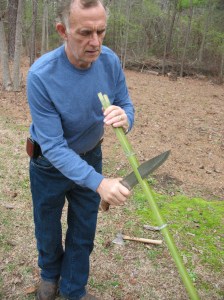
Use you hatchet and knife to shape the front profile of the bow. It should be about two inches wide in the middle and taper to about one inch on the tips. Pictured below: top, Shaping bow with the hatchet; middle, tapering the limbs; bottom, finished profile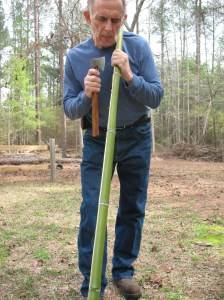
Next you can use your knife to carve a couple of notches in each end for the bowstring. Pictured below: Carving notches  Now it’s time to make the handle. Cut a stick that is about an inch to an inch-and-a-half in diameter and about a foot long. Taper the ends of the stick as shown below. Pictured below: tapering the handle stick
Now it’s time to make the handle. Cut a stick that is about an inch to an inch-and-a-half in diameter and about a foot long. Taper the ends of the stick as shown below. Pictured below: tapering the handle stick 
Carve out any joints in the area where the handle will rest then test the fit of the handle. Pictured below: top, carving out a joint; bottom, handle resting in place in the cane 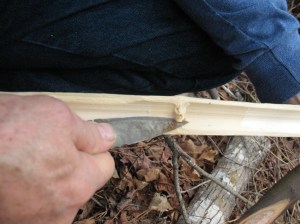
If the handle fits you can take some cordage and wrap the handle to secure it in place. In the illustration below I am using some yucca cordage that I had made earlier, but you can use para-cord, a shoelace, or anything else that you have. Pictured below: Wrapping handle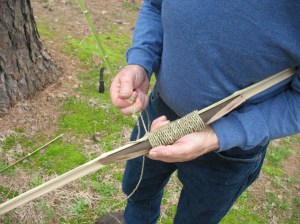
All you need now is a bowstring. I used some more yucca cordage for my bowstring. Pictured below: Finished bow, strung and ready for use This particular bow, which is only about a quarter inch thick, is not all that powerful, about twenty pounds; but thicker bamboo will make a more powerful bow. I wouldn’t hesitate to use this bow to try and take a rabbit, coon, possum, or other small game. Pictured below: Bamboo bow at full draw
This particular bow, which is only about a quarter inch thick, is not all that powerful, about twenty pounds; but thicker bamboo will make a more powerful bow. I wouldn’t hesitate to use this bow to try and take a rabbit, coon, possum, or other small game. Pictured below: Bamboo bow at full draw 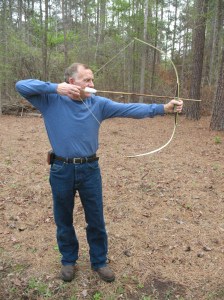
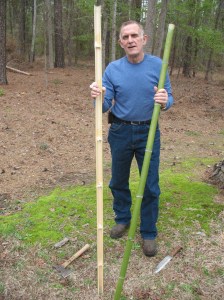
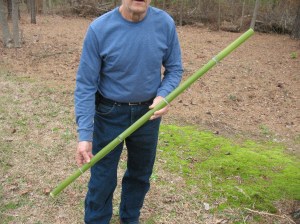
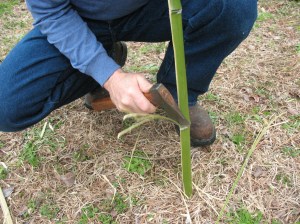


Hello! I just followed these directions (with some minor variations) and made a bamboo bow of about 25lbs draw weight. Very nice looking too! I have a question for you though… many bows which use Bamboo can be heat treated, blackening the bamboo and making it quite a bit more powerful. Would this method be at all compatible?
I have enough materials to make… say 8-10 more of this bow, but it takes me a good deal more than 30 minutes. Try 2 hours. (I lack a good machete or sharp hand ax to tiller with, had to use a small knife, and my seasoned bamboo is rather tough.) Would appreciate your opinion on this before I ruin one of these bows I’m making. Planning on giving some as Christmas gifts this year!
Vincent, I have to admit that I have never tried tempering bamboo by heating it. It sounds logical, as in using heat to fire harden an all-wood spear, but I’m just not sure. I have seen bamboo that has been lightly scorched when heating the limbs in order to recurve them but don’t know if this raised the draw weight any. If you try this I would definitely like to hear about the results. Hank
I’ve flame treated lots of bamboo and I haven’t ever observed that it made it any tougher but bamboo has some type of substance in it that when you heat it, it makes a beautiful glossy natural finish that looks like you sprayed it with polyurethane. Notice I don’t use the term “heat treated” because it’s not really the heat that makes this glossy finish. It has to be a flame. A flame from an acetylene torch is way too extreme and uncontrollable and I’ve found that a regular campfire works best, and a small handheld propane torch also works well. Just move the bamboo back and forth and keep it moving up and down until you get a consistent shine.
So, after doing more research on the effects of heat tempering bamboo, it seems that the tensile strength of the bamboo is compromised by heat tempering. While this is NOT a problem for bamboo facing towards the archer, the technique is not compatible with this bow design. I’m going to try to make a 2 layer version of this bow however. It shall be interesting. Also I’ve found that tapering 2″ -> 1″ is not necessarily the best idea for seasoned bamboo. I made a 1.25″ -> 1″ version of this bow as well, and it has significantly more casting speed. I’m unsure if a 2″ -> 1.5″ design is feasible, but as soon as I get some bigger bamboo I’ll be trying that out.
I also tried to make a version of this bow with higher poundage by shortening the limbs. Not sure if I was unlucky or if I need to sand the sides to a lower thickness, but it split down the middle of the bow. This would SEEM to indicate that I need to leave the bow width alone and adjust it by taking off the curved edges.
Just tried making this bow myself, but I have a radical difference in curvature in the limbs. Would tillering be effective in relieving this? not sure how it would work seems as though it would weaken it too much. well it is my first attempt and i do have plenty of bamboo to work with.
great site by the way been working my way thru it since i found it 2 day ago. lots of great info, keep it coming. thanks
You can tiller the limbs to some extent by making the stiffer limb narrower rather than thinner. Another possible problem might be that, even though the limbs are the same length, you have more joints on one of the limbs. This would tend to make that limb not bend as much. Play around with it and see what you come up with. Thanks for reading. Hank
Thanks for the reply, I have since discovered that limb with more curve has a section where the bamboo fibers folded into themselves, which only became more apparent after I had left it under tension for a little while. I will continue at it with new materials being a handtool woodworker I am not Prone to giving up so easily. I hope to use this as a stepping stone to move on to more complex construction methods. Thanks for the info.
Hi, from where can I buy the bamboo cane? I live in London
Thanks
Sid,
Many people in the USA grow bamboo as a decorative plant and it escapes cultivation to grow in the wild so there are virtual forests of it in some areas. I’m not sure if that happens in the UK. Small bamboo is often sold in garden centers to use for staking up plants. These could be used to make a bundle bow. As for large bamboo, I’m not sure where you would buy it.
Good luck,
Hank
Hi,
I thing that the best material for construction bow is fiberglass rod. They are flexible, but you canť break it.
You are 100% correct, but if you are in a wilderness survival situation you will be hard pressed to find any fiberglass growing in the wild.
Hank
I donť know how is it in USA but in Europe you can find in forest more fiberglass rods than bamboo (because it doesn’t grow here :D). But you are right, in real wilderness (Amazon rainforest etc.) you canť really find fiberglass rod but bamboo grow there.
Good point. Sometimes I forget that people are reading my posts all over the world. It’s easy to forget that other places don’t have entire forests of bamboo like we do in parts of East Texas. Hank
Great post! I live in Brazil and use a variation of this design as a quick bow for fishing in the lagoons along the southern coast and in the mangroove swamps, it works like charm!
Hi,
I would like to make a bow similar to this one, but cured so it lasts longer and is more powerful. Would it work to split the bamboo, shape the profile and add the handle before leaving it to cure? Or does the bamboo have to cure in full canes?
Bamboo seems to dry better as a whole cane. The little walls between the sections help the bamboo keep its shape. You can try splitting it first, but I haven’t had real good luck with that approach. Hank
Neat little build. While not truly “bamboo,” there is plenty of cane down here in Texas & Louisiana with similar properties. I’ll have to give this a try.
Let me make a few observations about bamboo bows made by native peoples in various parts of the world. Very often they are much smaller and typically, a shorter bow will be stiffer. Shortening your bow rather than leaving it thicker or wider might deliver the greater power you’re looking for. Can’t say for sure not having tried it myself…
Another thing. I noticed that you didn’t go into any detail about making the arrows for this little survival build. That might just come in handy. Typically, they can be made of slivers of bamboo/cane and fletched with a folded leaf. The points can be sharpened then heat hardened.
One more thing to try if you have more time on your hands is a small cross bow such as those made by the Montagnards and other such peoples in S/E Asia. Fairly simple to make and most decidedly effective About strings, especially for shorter bows or cross bows, they can also be made of twisted strips of the outer layer of young or green bamboo/cane.
Good info. I’ve been thinking about building a crossbow. I’ll have to do a little internet research on the subject. Thanks for reading. Hank
Tapering from any width to as narrow as possible gives the best curve for a bow of even thickness.
Obviously you can’t go to zero with nocks cut in from the side, but there are other ways to make nocks.
Nice survival bow 🙂 there are some awful ones on the web, but I love this one.
Hi, my yucca cordage keeps breaking when its dry. It only stays in one piece when its wet. Is this supposed to happen or am I doing something wrong in making it?
Devin, Your cordage should be just as strong when dry. Are you using good green leaves when you make the cordage or are they already dry and somewhat deteriorated? May be a different kind of yucca than grows around here. I am using Louisiana yucca, scientific name “yucca louisianesis.” Leaves are 2 to 3 feet long and 1/2 to 3/4 inch wide.
Hank
Hi, how long should the bow string be? i know that it depends on the bow’s length but im curious if there is a method to determine the length of the string.
Tyrone,
There are a lot of variables. The string material, how tight you twist up the string, how much the string stretches, how deep you want the bend in the strung bow, etc. I usually start with the un-twisted strands being 1 1/2 to 1 3/4 the length of the un-strung bow. This usually makes the finished string long enough. If in doubt, always err on the side of too long. Good luck.
Hank
Yes, err on the side of too long. If it’s too long, tying one knot in the string will reduce the total length by one inch.
Hi Hank, I’m just really curious on how far your bow or a bamboo bow like that could shoot an arrow.
Tyrone,
I’m really sorry, but I made this bow several years ago, I no longer have it, and I don’t really recall ever shooting it for distance. I do remember that it was pretty light, probably 20 to 25 pounds, but it had pretty fast recovery. If I had to guess I would say it would shoot maybe 60 – 75 yards, but that’s a pure guess.
Hank
Do you think you Could you double up the bamboo for added draw strength??
Rob,
You can layer the bamboo and wrap several binds of cordage to hold it together or you can use smaller whole bamboos and make a bundle bow. See this post on making a bundle bow https://sensiblesurvival.org/2012/05/03/make-a-bamboo-bundle-bow/
This is pretty neat. I imagine you could make it more powerful by layering progressively smaller slats of bamboo on the inner side of the bow. Kind of like making a leaf spring.
Hmm is anyone else experiencing problems with the images on this blog
loading? I’m trying to determine if its a problem on my end or
if it’s the blog. Any suggestions would be greatly appreciated.
Here in my part of Texas, we have a lot of Chinese bamboo that has escaped cultivation and grown into jungles in some areas. It spreads rapidly by underground runners an it’s very cold hardy. Last winter, it froze to the ground but quickly recovered in spring. Regarding the UK, even if it’s not common there, it would grow very well there. I made a crossbow from bamboo and am working on other ones.